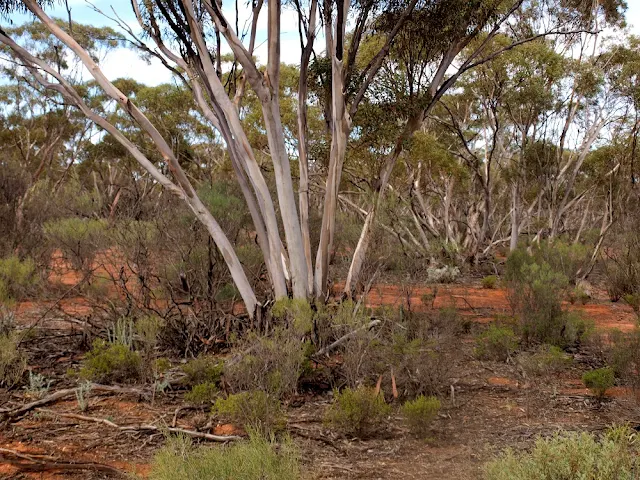Notwithstanding the dramatic and lamentable effects of
bushfires on human life and infrastructure, it is perhaps timely here at the Friends of Drouin's Trees to contemplate
the ecological effects of bushfire on the Australian landscape.
Bushfires can kill individual plants and animals, destroy
large plant communities that may take years to recover, cause erosion and
sedimentation, open new areas to infestation of weed and feral species. Fire
can also trigger the germination of many native plants, clear undergrowth to
allow new seedlings to grow, help form hollows in logs and trees for wildlife
and encourage new growth through epicormic buds and lignotubers on many native
trees.
As climate changes advance and our summers become longer,
hotter and drier, the frequency of uncontrollable bushfires is inevitably going
to increase, researchers say.
Plants and bushfires
Many Australian plants cope very well with a particular fire
regime. They grow, mature and produce seed between fire events. When a fire
does occur, the understorey is cleared, seed is germinated and new seedlings
appear.
 |
| Banksias and other species often need heat from a fire to open their seed capsules - Grantville 2019. |
If fire events are too frequent, these plants may not
have time to produce sufficient seed and they begin to die out.
If fire events are too infrequent, (due to
suppression, etc), some species can grow old and die thus a seed source is lost
and the species begins to die out.
 |
| Grantville NCR - Grass Trees have survived but most other understorey is destroyed. |
Much research is taking place to determine just what
frequency of fire events do certain species require in order to ensure their
survival. How to achieve the right balance is the debate that occupies
advocates and opponents of controlled burning.
 |
| Epicormic shoots about 1 month after the Grantville NCR fire. |
Smoke from a fire can stimulate and assist the germination
of many native plants too – Hibbertia, Grevillea, Hakea, etc. In fact, some
horticulturists are now using smoke to generate more reliable germination of
some previously difficult to propagate species.
Birds and bushfires
Black Kites, Whistling Kites and Brown Falcons are three
birds of prey that are frequently observed in the vicinity of active bushfire
fronts, as they swoop on terrestrial prey that are flushed from their cover by
the approaching fire. Indeed, there is evidence of some raptor species actually
carrying lighted sticks from behind a dying bushfire and dropping them into the
unburnt dry grassland on the flanks to keep the fire alive – so much for ‘dumb
animals’!
 |
| Credit: Dick Eussen. Black Kites swooping on small animals as they try to flee a fire. |
Many birds are able to escape a fire under normal
circumstances. However, just how they cope after the event, with reduced areas
of habitat and perhaps over-crowding of the unburnt areas into which they have sought
refuge, remains largely unknown.
Anecdotally, frequent reports have been made of birds
expiring from heat stress some distance from a fire due to the elevated
temperatures caused by the radiant heat, rather than from the fire itself.
Other animals and
bushfires
Mammals and reptiles may not be so fortunate. Animals like
Kangaroos that can move quickly may have some success in escaping the flames
but others, like Koalas, remain very vulnerable to the threat of bushfires.
Burrowing animals such as Wombats of course might be able to
survive the initial passage of a fire by remaining in their burrows, but they
may well face a battle afterwards as their food source has been destroyed.
 |
| Credit - ABC News 15 Sep 2017 and Jackie Dixon. Wombat has survived the fire - the future? |
Some animal welfare bodies often get permission to enter a
fire ground shortly after the passing of a bushfire to euthanise, rescue or
monitor surviving animals.
There are numerous reports of animals that normally would
compete with one-another, actually sharing the shelter of a cool, damp area in
a deep gully or under a rock ledge, etc as a fire front passes through their
environment.
Fungi and bushfires
Fungi are essential components of all ecosystems. They act
as decomposers, nutrient recyclers and many are a food source for various
animals. A bushfire can dramatically affect the role of fungi.
There are species of fungi that rely on fire and smoke for
the germination of their spores. Many fungi are stimulated to produce their
fruiting bodies after a bushfire. In some instances, fungi are the first living
organism to appear after a fire.
 |
| Hollow log formed by fire - Grantville NCR. |
The destruction by fire of some micro-organisms in the soil
that are detrimental to fungi, will sometimes stimulate the reproduction of a
fungus. These relationships can be complex, not fully understood and are being
researched continually.
The Australian landscape has been recovering from fire for
millions of years and every bushfire has an effect on the flora, fauna and
fungi that can result in frequent changes to habitat, some good, some not so –
a fact we sometimes need to be more respectful of at times.
Related links














